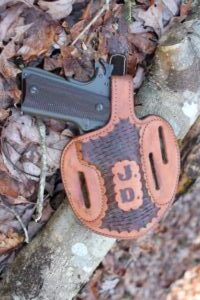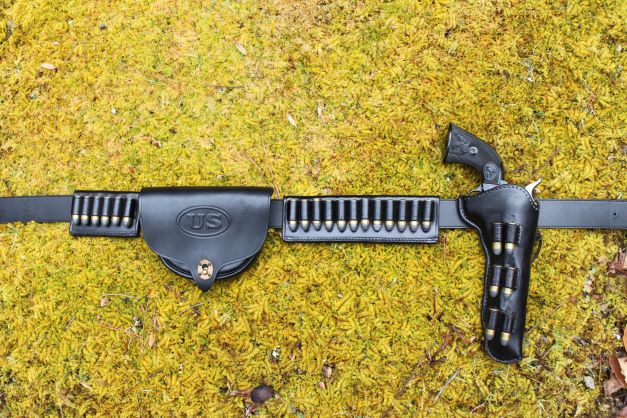
By Jim Dickson | Contributing Writer
A holster is a necessity for carrying a handgun and they come in a bewildering variety of designs and materials.
I have used all types of holsters over the years, and what follows are my personal observations.
The full flap military holster as exemplified by the U.S. M1916 holster for the .45 automatic offers the best protection for the gun for open carry. The M1916 is also a fast draw holster drawing heavily on the American gunfighting experience. There is even a leather covered wood block that positions the gun away from the body for quicker grasping.
To accomplish a fast draw from this holster, use the tie down thongs to keep it from rising up in the draw. Now flip the flap up with your thumb as you go for the gun and immediately start curling your fingers around the grip as you draw, starting with the little finger. The safety of the cocked and locked pistol is wiped off as the gun is halfway to the target and you are ready to fire. As the leather tie down thongs tend to rot and break I use military nylon boot laces instead. For a military open carry holster the M1916 is perfection.
For those wanting a concealed carry option, the pancake-type holster works best. It will hide a M1911A1 under just a shirt, yet is comfortable to wear and quick to draw. If you are having to sleep with your gun on you won’t wake up when you roll over on the M1911A1’s side. Now that’s as comfortable as holster gets.
The pancake can be worn as an open carry or a concealed carry holster. It holds the pistol comfortably yet tight against your side. I have used an original 1970’s first production pancake holster for my Model 1911A1 daily since it first came off the production line. It is much patched and repaired but it still serves me well. If you can only have one holster, make it a pancake holster.
Old West holsters for the Colt Single Action Army work as good as ever. The Slim Jim, originally made by cutting down a military flap holster, was the first and best. I use an El Paso Saddlery copy of the one John Wesley Hardin used to carry a Colt .45 SAA. Later the Mexican loop holster became popular as well. The Buscadero rigs, so beloved by Hollywood cowboys, actually first came out on the TexMex border in the 1930’s. I have not found them any faster than the Slim Jim holsters and they certainly don’t hold the gun in as securely. I have found the Wes Hardin holster keeps the gun in securely without any safety strap and that’s important as I normally get only a fleeting second to draw and fire at a coyote on my farm.
The most common commercial holster in the 1930’s, 40’s, and 50’s was one with a snap going from the belt loop to the front of the holster that enabled it to be taken on and off the belt by utilizing the snap. I never knew anyone who made use of this feature though. You have to have a lot of slack in your belt and it is just easier to take it off by sliding it off the belt.
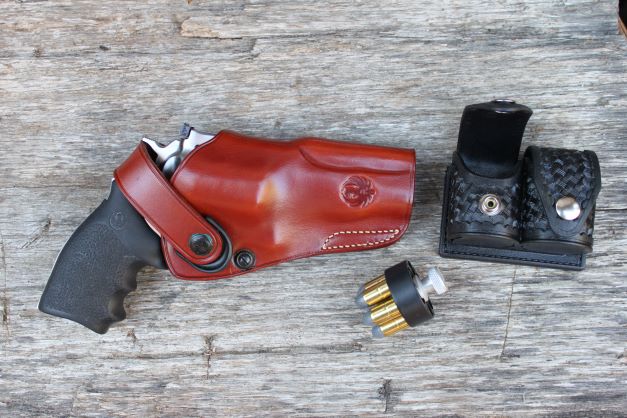
Holsters slanted forwards for a fast draw are increasingly popular.
The old Berns-Martin break front holsters were intended to be the last word in a quick draw holster and they certainly were fast.
Cross draw holsters are sometimes used and these have sometimes been made to break at the back for speed. If you are carrying a long gun, the cross draw holster keeps the two guns from banging against each other. The third belt loop on pancake holsters gives you that option when you need it and is another reason the pancake ranks as the most versatile design.
The inside-the-pants holster is commonly seen. These usually are thin leather with a belt clip. They are very concealable but not the most comfortable of holsters. A lot depends on what gun is carried and how it fits the individual’s body. The best ones I have used are the “Sticky Holsters.” They are not sticky to the touch but they stay in whatever position that you put them. The result is that they are the most comfortable and concealable holsters of their type. They can also be used inside the pocket.
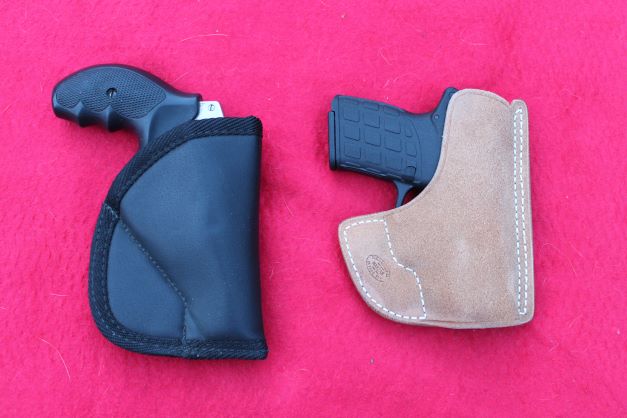
Carrying a pistol inside the pocket is one place you really need a holster to keep the gun safe from coins, keys, lint, sand, and the dirt that accumulates in pockets. They are usually made of suede and often have a hook in their profile to make sure they stay put when the gun is drawn. They also serve to keep the handgun positioned properly in the pocket. You should never carry a pistol in the pocket without a pocket holster.
Cross draw holsters are not faster but they can offer a means of drawing a long barreled gun provided they ride at an angle or they have a sufficiently long belt loop to allow the gun to be drawn at an angle like a sword. They offer an advantage while sitting and El Paso Saddlery makes a duplicate of Doc Holliday’s very low slung shoulder holster that rides just above the belt which he used to draw while sitting at a card table.
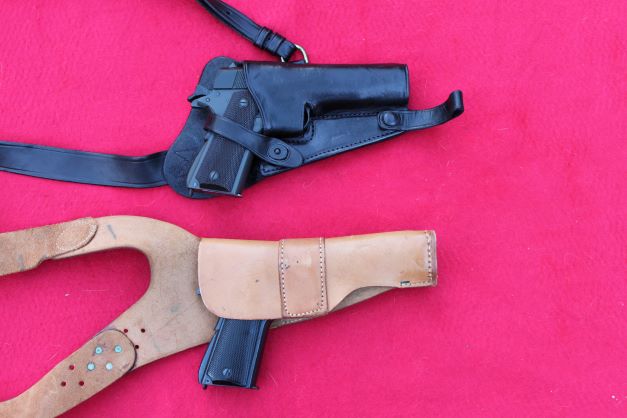
Shoulder holsters have their place. The army developed a cross between a shoulder holster and a chest holster that enables a vehicle driver or crewman to instantly draw his gun while seated. The strap across the chest makes hiding this holster problematic though. It is, however, an extremely secure and fast rig.
The commercial spring clamp shoulder holsters are exceedingly fast to draw but the gun can bounce out if you jump across a stream.
Some shoulder holsters depart from the traditional position of the pistol hanging down and angle the gun horizontally while some hold the gun upside down with the muzzle pointed at your armpit. The latter makes me nervous and I don’t like them.
Ankle holsters are hard to draw quickly from and most of them hurt to wear. They enable a back-up pistol to be carried very discreetly but are a pain to use. Like most deep cover holsters they are extremely slow to use compared to conventional holsters. The ankle holster also demands some extremely awkward and unnatural movements to draw.
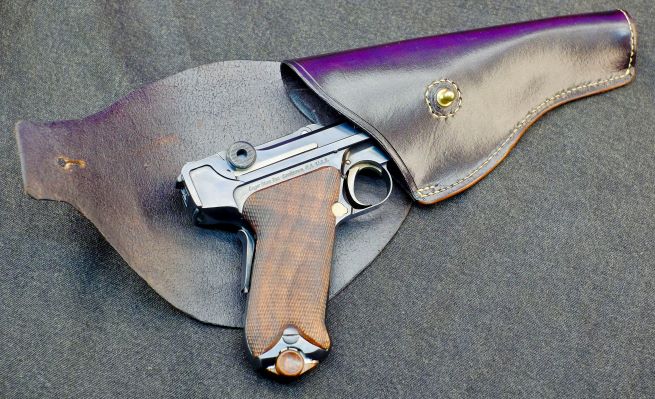
The pistol is retained within the holster by a number of stratagems. The first and best was the full flap used on military holsters to this day. It offers the most security as well as the most protection for the gun. These were normally anchored by a stud going through the flap. Note the photo of duplicate of the original holster for the M1907 U.S. Army Test Trials Luger in .45ACP. Both the guns and the holsters are available from Eugene Golubstov, AKA Lugerman.
This was followed by the bucking thong which was a leather shoelace that looped over the gun’s hammer to keep it in place when busting broncs. You wore a Colt .45 while doing this in case you got thrown and your high heeled cowboy boot got caught in the stirrup. If this happened, you had to shoot the horse to prevent being dragged to death. Designed to kill a cavalry horse at 100 yards, the .45 Colt had no problem stopping a wild horse at point blank range. The bucking strap was secure enough but the downside was that it was a bit slow to get off and some men were killed in gunfights while they were still trying to get their bucking strap off the hammer.
The safety snap strap was a big improvement but you could easily fumble getting it off in an emergency. A lot of men took to unfastening it at the first hint of trouble as a result.
The thumb break snap is designed for the user to push down on the safety snap with the thumb when drawing. It proved to be fast and reliable, and is extremely popular today.
Two other methods that have become popular are screw tensioning the force required to draw the gun and making a tight holster that the gun can only be drawn from at the correct angle “to prevent someone from grabbing and drawing your gun.” I don’t like either.
When I need my gun in a hurry I don’t need to struggle with it, and I certainly don’t want it hanging up if my draw is sloppy. I won’t use a holster until it is broken in and the handgun can be drawn smoothly.
Ammunition for reloads must be carried and the semi-automatic pistol with spare magazines in belt pouches is the hands down winner in reloads. Among revolvers you have the excellent HKS Speedloaders that carry a cylinder full of cartridges that can be quickly loaded. These may be carried in pouches on the belt.
Single actions revolvers need a U.S. Cavalry ammunition belt pouch such as the reproduction made by Pacific Canvas and Leather Co. or cartridge loops in the belt. El Paso Saddlery also makes belt slide with loops that convert any belt into a cartridge belt. Their duplicate of the holster carried by John Wesley Hardin has six loops stitched on the front of the holster that I find very handy. Hardin was the deadliest gunfighter of the old West with the highest score of men killed. His holsters featured his own innovations that are well worth having.
There is a bewildering variety of holsters as you can see. If you have doubts as to what holster to buy just get a pancake holster. They do everything well.

